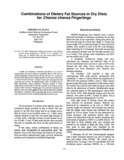The essential fatty acid requirement of milkfish (Chanos chanos Forsskal)
- Global styles
- MLA
- Vancouver
- Elsevier - Harvard
- APA
- Help

View/
Date
1992Author
Page views
4,013ASFA keyword
AGROVOC keyword
Taxonomic term
Metadata
Show full item record
Share
Abstract
The essential fatty acid (EFA) requirement of milkfish was examined by a 12-week feeding trial using defined, purified diets at water temperature of 28–29°C and salinity of 32‰. The test diets contained varying levels of 18:0 (triglyceride form, TG), 18:3(n−3), 18:2(n−6) and (n−3) highly unsaturated fatty acids (n−3 HUFA). Milkfish juveniles were starved for 7 days and were than fed lipid-free diet for 30 days before the initiation of feeding trials. Low growth and feed efficiency together with high mortalities were observed in fish fed the lipid-free diet as well as in the EFA-deficient diet. Supplementation of 2% 18:2(n−6) to the tristearin based diet did not improve growth rate of milkfish as effectively as feeding with (n−3) fatty acids. The highest weight gain was obtained in milkfish fed a combination of 5% 18:0 + 1.0% 18:3(n−3) + 0.5% 20:5(n−3) + 0.5% 22:6(n−3) although the supplementation of 2% 18:3(n−3) alone or combination of 0.5% 20:5(n−3) + 0.5% 22:6(n−3) to the tristearin based diets were also effective for improvement of growth. Thus, (n−3) fatty acids, such as 18:3(n−3) and (n−3)HUFA were nutritionally more important than 18:2(n−6) for milkfish. The fatty acid composition of the polar lipids from whole body of milkfish juveniles fed the various test diets were influenced by the composition of the dietary fatty acids.
Suggested Citation
Borlongan, I. G. (1992). The essential fatty acid requirement of milkfish (Chanos chanos Forsskal). Fish Physiology and Biochemistry , 9(5-6), 401-407. https://doi.org/10.1007/BF02274221
Type
ArticleISSN
0920-1742Collections
- Journal Articles [1258]
Related items
Showing items related by title, author, creator and subject.
-
Milkfish, Chanos chanos
Lim, Chhorn; Borlongan, Ilda G.; Pascual, Felicitas P. (CAB International Publishing, 2002)This chapter reviews information on nutrient requirements, feeds and feeding practices of milkfish. -
Series: JIRCAS Working Report;No. 35
Notable features of fatty acid composition in mangrove fish species
Ogata, Hiroshi Y.; Emata, Arnil C.; Garibay, Esteban S. (Japan International Center for Agricultural Sciences, 2003)Fatty acid composition was determined in several mangrove and commercial species, mangrove red snapper, rabbitfish, milkfish and striped jack that were sampled in the Central Philippines, with special reference to arachidonic ... -
Combinations of dietary fat sources in dry diets for Chanos chanos fingerlings
Alava, Veronica R. (Asian Fisheries Society, 1986)A study was conducted to determine the effects of 1:1 ratio of several dietary fat sources added in semipurified diets at 10% level on milkfish fingerlings. Results showed that the cod liver oil + coconut oil diet promoted ...





